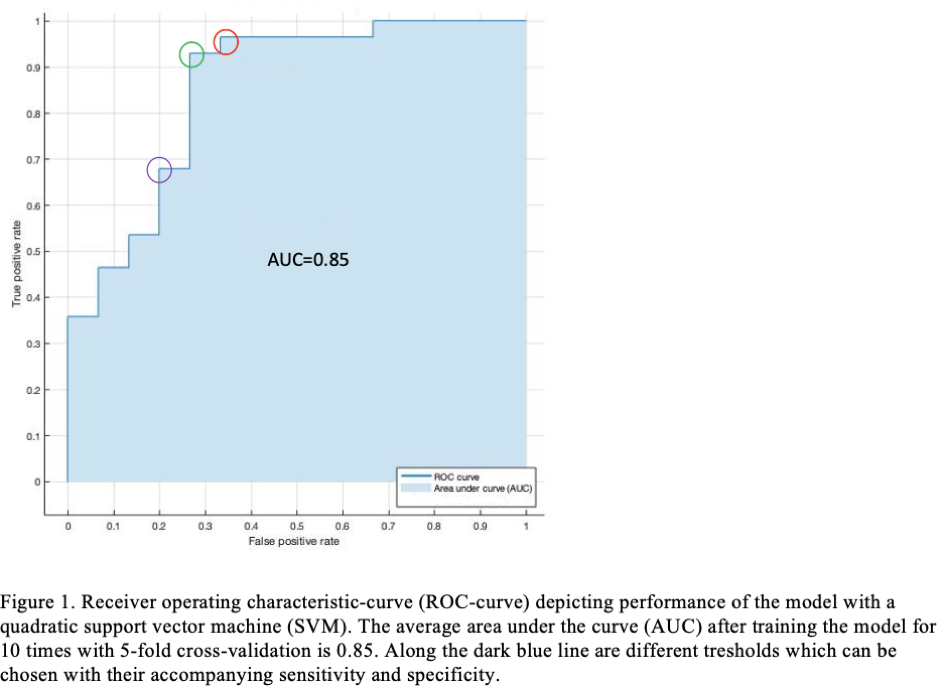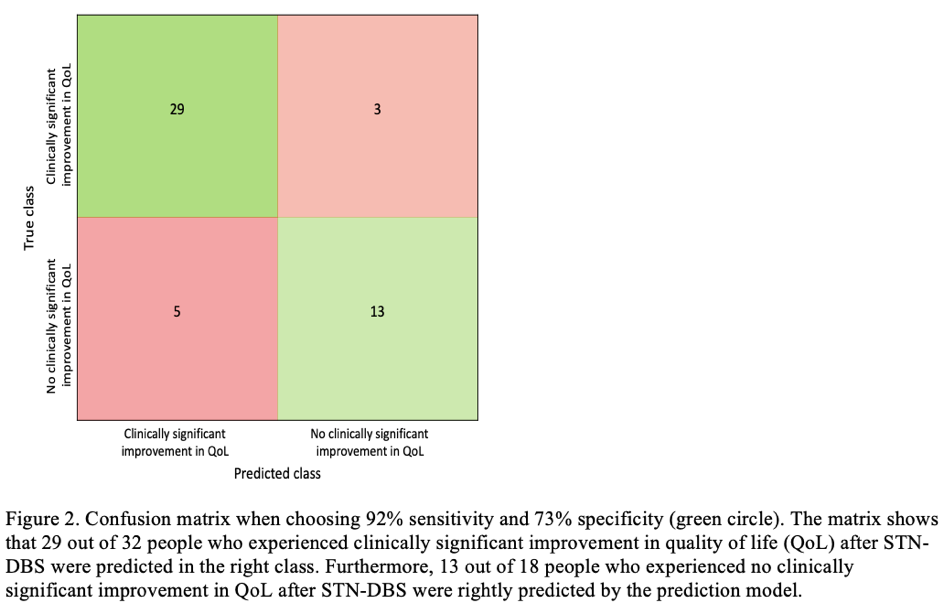Category: Surgical Therapy: Parkinson's Disease
Objective: The aim of this study was to develop a model using machine learning for patients with Parkinson’s disease (PD) to predict clinically important improvement in quality of life (QoL) after deep brain stimulation (DBS) of the subthalamic nucleus (STN).
Background: Despite the generally positive effect of STN-DBS on motor function, not all patients experience an improvement in QoL [1, 2]. No consensus has been reached on which parameters are most predictive for QoL-outcome and a valid prediction model is currently unavailable.
Method: Patients with PD and STN-DBS were retrospectively selected from the DBS-database of the Amsterdam UMC. Clinically important QoL-improvement was defined as -1.6 points on the Parkinson’s Disease Questionnaire 39 (PDQ-39) [3], which was used for class division. Preoperative demographic and disease-specific data as well as preoperative UPDRS I-IV-, apathy-, neuropsychological examination- and PDQ-39 scores were used as parameters. Using data-driven feature selection, the most predictive variables were selected. For the design of the model, support vector machines (SVMs) were trained 10 times using 5-fold cross-validation.
Results: 50 PD-patients were retrospectively selected: 32 patients with and 18 patients without clinically important improvement in QoL. No significant differences in preoperative variables were present between groups. It was possible to use a quadratic SVM to predict QoL-outcome after STN-DBS. The model performed with an average area under the curve (AUC) of 0.85 [Figure 1]. At 92% sensitivity, the model predicted the outcome correctly for 42 out of 50 patients [Figure 2]. Seven preoperative variables were incorporated in the model: sex, most invalidating symptom, UPDRS-II-, UPDRS-III OFF-, GIT visuospatial subtest- and PDQ-39 score.
Conclusion: With our support vector machine model, we were able to predict clinically important improvement in QoL after STN-DBS in PD-patients. While individual variables did not significantly differ between groups, machine learning showed its added value by combining these variables in a more comprehensive model. The model has to be further validated using prospective data and needs to be optimized for clinical practice. Ultimately, the model may be used to better select candidates for DBS-surgery and manage a patient’s expectations.
References: [1] V. J. Odekerken et al., “Subthalamic nucleus versus globus pallidus bilateral deep brain stimulation for advanced Parkinson’s disease (NSTAPS study): a randomised controlled trial,” Lancet Neurol, vol. 12, no. 1, pp. 37-44, Jan 2013, doi: 10.1016/S1474-4422(12)70264-8. [2] V. Voon, C. Kubu, P. Krack, J. L. Houeto, and A. I. Troster, “Deep brain stimulation: neuropsychological and neuropsychiatric issues,” Mov Disord, vol. 21 Suppl 14, pp. S305-27, Jun 2006, doi: 10.1002/mds.20963. [3] V. Peto, C. Jenkinson, and R. Fitzpatrick, “Determining minimally important differences for the PDQ-39 Parkinson’s disease questionnaire,” Age Ageing, vol. 30, no. 4, pp. 299-302, Jul 2001, doi: 10.1093/ageing/30.4.299.
To cite this abstract in AMA style:
E. Rouleau, W. Potters, D. Pina Fuentes, M. Bot, J. Dijk, R. Schuurman, R. de Bie, M. Beudel. Machine Learning Predicts Clinically Important Improvement in Quality of Life after STN-DBS in Patients with Parkinson’s Disease [abstract]. Mov Disord. 2020; 35 (suppl 1). https://www.mdsabstracts.org/abstract/machine-learning-predicts-clinically-important-improvement-in-quality-of-life-after-stn-dbs-in-patients-with-parkinsons-disease/. Accessed December 16, 2025.« Back to MDS Virtual Congress 2020
MDS Abstracts - https://www.mdsabstracts.org/abstract/machine-learning-predicts-clinically-important-improvement-in-quality-of-life-after-stn-dbs-in-patients-with-parkinsons-disease/


